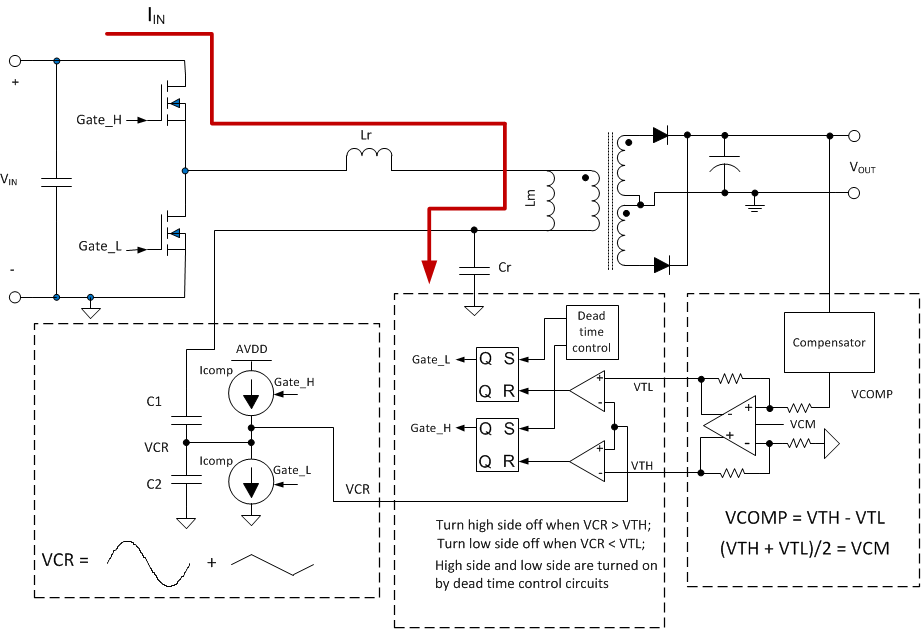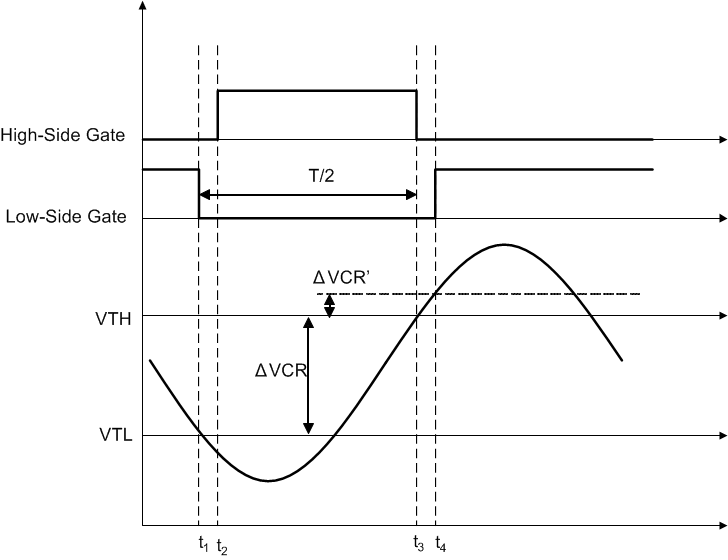SLUSCU6C August 2017 – January 2020 UCC256301
PRODUCTION DATA.
- 1 Features
- 2 Applications
- 3 Description
- 4 Revision History
- 5 Pin Configuration and Functions
- 6 Specifications
-
7 Detailed Description
- 7.1 Overview
- 7.2 Functional Block Diagram
- 7.3
Feature Description
- 7.3.1 Hybrid Hysteretic Control
- 7.3.2 Regulated 12-V Supply
- 7.3.3 Feedback Chain
- 7.3.4 Optocoupler Feedback Signal Input and Bias
- 7.3.5 System External Shut Down
- 7.3.6 Pick Lower Block and Soft Start Multiplexer
- 7.3.7 Pick Higher Block and Burst Mode Multiplexer
- 7.3.8 VCR Comparators
- 7.3.9 Resonant Capacitor Voltage Sensing
- 7.3.10 Resonant Current Sensing
- 7.3.11 Bulk Voltage Sensing
- 7.3.12 Output Voltage Sensing
- 7.3.13 High Voltage Gate Driver
- 7.3.14 Protections
- 7.4 Device Functional Modes
-
8 Application and Implementation
- 8.1 Application Information
- 8.2
Typical Application
- 8.2.1 Design Requirements
- 8.2.2
Detailed Design Procedure
- 8.2.2.1 LLC Power Stage Requirements
- 8.2.2.2 LLC Gain Range
- 8.2.2.3 Select Ln and Qe
- 8.2.2.4 Determine Equivalent Load Resistance
- 8.2.2.5 Determine Component Parameters for LLC Resonant Circuit
- 8.2.2.6 LLC Primary-Side Currents
- 8.2.2.7 LLC Secondary-Side Currents
- 8.2.2.8 LLC Transformer
- 8.2.2.9 LLC Resonant Inductor
- 8.2.2.10 LLC Resonant Capacitor
- 8.2.2.11 LLC Primary-Side MOSFETs
- 8.2.2.12 Design Considerations for Adaptive Dead-Time
- 8.2.2.13 LLC Rectifier Diodes
- 8.2.2.14 LLC Output Capacitors
- 8.2.2.15 HV Pin Series Resistors
- 8.2.2.16 BLK Pin Voltage Divider
- 8.2.2.17 BW Pin Voltage Divider
- 8.2.2.18 ISNS Pin Differentiator
- 8.2.2.19 VCR Pin Capacitor Divider
- 8.2.2.20 Burst Mode Programming
- 8.2.2.21 Soft-Start Capacitor
- 8.2.3 Application Curves
- 9 Power Supply Recommendations
- 10Layout
- 11Device and Documentation Support
- 12Mechanical, Packaging, and Orderable Information
Package Options
Mechanical Data (Package|Pins)
- DDB|14
Thermal pad, mechanical data (Package|Pins)
Orderable Information
7.3.1 Hybrid Hysteretic Control
UCC256301 uses a novel control scheme – Hybrid Hysteretic Control (HHC) - to achieve best in class line and load transient performance. The control method makes the compensator very easy to design. The control method also makes light load management easier and more efficient. Improved line transient enables lower bulk capacitor/output capacitor value and saves system cost.
HHC is a control method which combines traditional frequency control and charge control – It is charge control with added frequency compensation ramp. Comparing with traditional frequency control, it changes the power stage transfer function from a 2nd order system to a 1st order system, so that it is very easy to compensate. The control effort is directly related to input current, so the line and load transients are best in class. Comparing with charge control, the hybrid hysteretic control avoids unstable condition by adding in a frequency compensation ramp. The frequency compensation makes the system always stable, and makes the output impedance lower as well. Lower output impedance makes the transient performance better than charge control.
In summary, the problems solved by HHC are:
- Help LLC converters achieve best in class load transient and line transient
- Changes the small-signal transfer function to a 1st order system which is very easy to compensate, and can achieve very high bandwidth
- Inherently stable via frequency compensation
- Makes burst mode control high efficiency optimization much easier
Figure 28 shows the HHC implementation in UCC25630: a capacitor divider (C1 and C2) and two well matched controlled current source.
 Figure 28. UCC256301 HHC Implementation
Figure 28. UCC256301 HHC Implementation The resonant capacitor voltage is divided down by the capacitor divider formed by C1 and C2. The current sources are controlled by the gate drive signals. When high side switch is on, turn on the upper current source to inject a constant current into the capacitor divider; when low side switch is on, turn on the lower current source to pull the same amount of constant current outside of the capacitor divider. The two current sources add a triangular compensation ramp to the VCR node. The current sources are supplied by a reference voltage Vref. This voltage needs to be equal to or larger than twice of the common mode voltage VCM. The divided resonant capacitor voltage and the compensation ramp voltage are then added together to get VCR node voltage. If the frequency compensation ramp dominates, the VCR node voltage will look like a triangular waveform, and the control will be similar to direct frequency control. If the resonant capacitor voltage dominates, the shape of the VCR node voltage will look like the actual resonant capacitor voltage, and the control will be similar to charge control. This is why the control method is called “hybrid” and the compensation ramp is called frequency compensation.
This set up has an inherent negative feedback to keep the high side and low side on time balanced, and also keep the common mode voltage at VCR node at VCM.
There are two input signals needed for the new control scheme: VCR and VCOMP. VCR is the sum of the scaled down version of the resonant capacitor voltage and the frequency compensation ramp. VCOMP is the voltage loop compensator output. The waveform below shows how the high-side and low-side switches are controlled based on VCR and VCOMP. The common mode voltage of VCR is VCM.
 Figure 29. HHC Gate On/Off Control Principle
Figure 29. HHC Gate On/Off Control Principle Based on VCOMP and VCM (3 V), two thresholds: Vthh and Vthl are created.


The VCR voltage is compared with the two thresholds. When VCR > Vthh, turn off high side switch; when VCR < Vthl, turn off low side switch. HO and LO turn on edges are controlled by adaptive dead time circuit.